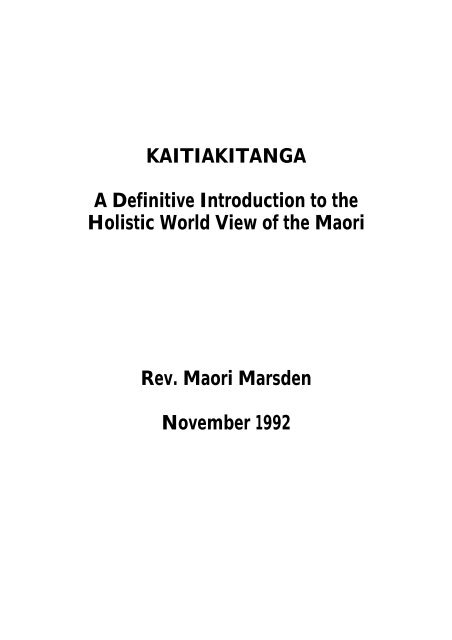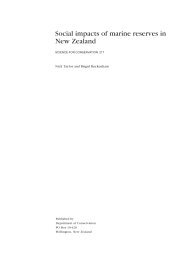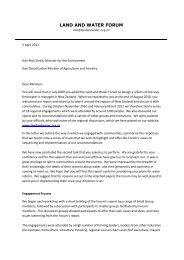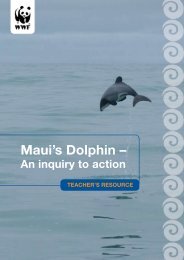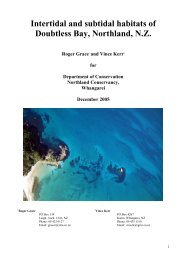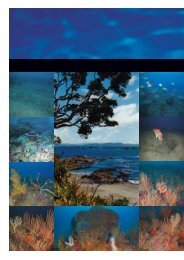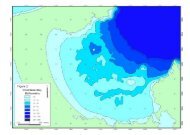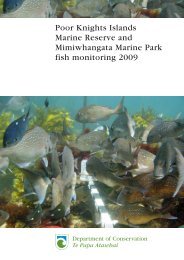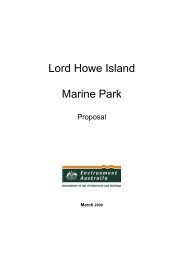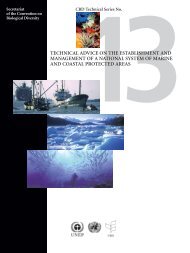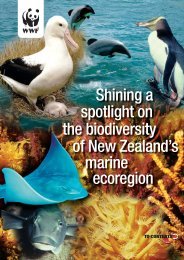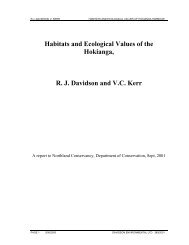KAITIAKITANGA A Definitive Introduction to the ... - MarineNZ.org.nz
KAITIAKITANGA A Definitive Introduction to the ... - MarineNZ.org.nz
KAITIAKITANGA A Definitive Introduction to the ... - MarineNZ.org.nz
You also want an ePaper? Increase the reach of your titles
YUMPU automatically turns print PDFs into web optimized ePapers that Google loves.
<strong>KAITIAKITANGA</strong><br />
A <strong>Definitive</strong> <strong>Introduction</strong> <strong>to</strong> <strong>the</strong><br />
Holistic World View of <strong>the</strong> Maori<br />
Rev. Maori Marsden<br />
November 1992
1. INTRODUCTION<br />
<strong>KAITIAKITANGA</strong><br />
Table of Contents<br />
2. FUNDAMENTAL KNOWLEDGE<br />
3. THE WORLDS OF MAORI COSMOGONY<br />
3.1 The Lore Of The Wananga<br />
3.2 The Baskets Of Knowledge<br />
3.2.1 Tua – Uri<br />
3.2.2 Te Aro-Nui<br />
3.2.3 Te Ao Tua-Atea<br />
4. SOME CONCLUSIONS<br />
4.1 Legends and Myths<br />
4.2 The Use Of legendary Myth And S<strong>to</strong>ry<br />
4.3 Aid For Ease Of Recall<br />
4.4 Sanctions<br />
5. GENEALOGY<br />
6. THE HOLISTIC VIEW<br />
6.1 Natural Science<br />
6.1.1 Positivism<br />
6.1.2 Relativism<br />
6.1.3 Freud
6.2 The New Physicists<br />
6.2.1 Open System<br />
6.2.2 Integrated Whole<br />
7. MOTHER EARTH AND MAN<br />
8. KAUPAPA AND TIKANGA<br />
9. <strong>KAITIAKITANGA</strong><br />
9.1 Definition<br />
9.2 Spiritual Guardians<br />
9.3 Western Values<br />
9.4 Mo<strong>the</strong>r Earth<br />
9.5 Earth’s Consciousness<br />
9.6 Tikanga Tiaki (Guardianship Cus<strong>to</strong>ms<br />
9.7 Rahui And Mauri<br />
9.8 Kawa<br />
9.8.1 The Institution Of Rahui<br />
9.8.2 An Aside<br />
10. OTHER TERMS<br />
10.1 Taiapure<br />
10.2 Tuku Rangatira<br />
11. CONCLUSION
1<br />
<strong>KAITIAKITANGA</strong><br />
1. INTRODUCTION<br />
The purpose of <strong>the</strong> resource Management Act is <strong>to</strong> promote <strong>the</strong> sustainable<br />
management of natural and physical resources (sec 3(1)). By definition<br />
‘sustainable’ management includes <strong>the</strong> protection of <strong>the</strong> community’s enjoyment<br />
of those natural and physical resources. In achieving those purposes, matters of<br />
national importance are specified. One of those matters is a requirement <strong>to</strong><br />
recognise and provide for <strong>the</strong> relationship of Maori and <strong>the</strong>ir culture and<br />
traditions with <strong>the</strong>ir ancestral lands, water, sites, wahi tapu and our taonga.<br />
One of <strong>the</strong> major concerns for Maori is that <strong>the</strong> cultural and spiritual decisions of<br />
Maori concerning <strong>the</strong>ir taonga were left <strong>to</strong> <strong>the</strong> discretion of local authorities and<br />
<strong>the</strong> Planning tribunal. By <strong>the</strong> ground rules provided in Parts I and II of <strong>the</strong> Act,<br />
<strong>the</strong>y are not. However, if <strong>the</strong> ground rules are misunders<strong>to</strong>od or ignored, <strong>the</strong>n<br />
<strong>the</strong>y are.<br />
The intention of <strong>the</strong> Act, in its definitions and in <strong>the</strong> matters specified as being of<br />
national importance, is unambiguous. There is a manda<strong>to</strong>ry obligation upon all<br />
persons exercising powers under <strong>the</strong> Act who recognise and make provision for<br />
Maori cultural values in all aspects of resource management, in <strong>the</strong> preparation<br />
and administration of Regional and District Plans. Section 7 reiterates <strong>the</strong><br />
cultural emphasis.<br />
The reference <strong>to</strong> ‘Kaitiakitanga’ in section 7(a) is specific. It applies <strong>to</strong><br />
traditional Maori ‘guardianship’ over such resources as native forests and<br />
kaimoana.<br />
Part II of <strong>the</strong> resource Management Act deals with <strong>the</strong> ‘purpose and principles’<br />
which provide <strong>the</strong> ground rules for everyone exercising powers under <strong>the</strong> Act,<br />
concludes with section 8 which requires that <strong>the</strong> ‘principles of <strong>the</strong> Treaty’ be<br />
taken in<strong>to</strong> account in <strong>the</strong> management of natural resources. this acknowledges<br />
<strong>the</strong> Crown’s obligation under Article II of <strong>the</strong> treaty <strong>to</strong> preserve for Maori <strong>the</strong>ir<br />
culture and traditional way of life. <strong>the</strong> Act lays down <strong>the</strong> ground rules by which<br />
<strong>the</strong>se obligation are <strong>to</strong> be met in <strong>the</strong> preparation and administration of plans for<br />
<strong>the</strong> management of New Zealand resources.<br />
Section 8 provides that: In achieving <strong>the</strong> purpose of this Act, all persons<br />
exercising functions and powers under it, in relation <strong>to</strong> managing <strong>the</strong> use,<br />
development, and protection of natural and physical resources shall take in<strong>to</strong><br />
account <strong>the</strong> principles of <strong>the</strong> Treaty of Waitangi’.
2<br />
This provision introduces <strong>the</strong> Treaty partners in<strong>to</strong> <strong>the</strong> management of our natural<br />
resources. this is an acknowledgement that <strong>the</strong>re is a separately identifiable<br />
interest of one of those parties, ie, <strong>the</strong> Maori which must be taken in<strong>to</strong> account,<br />
‘In achieving <strong>the</strong> purpose of this Act’ by <strong>the</strong> application of <strong>the</strong> principles of <strong>the</strong><br />
Treaty of Waitangi in <strong>the</strong> management by <strong>the</strong> Crown, <strong>the</strong> o<strong>the</strong>r part, or its<br />
delegated authority (Regional and Local Bodies) of natural resources.<br />
Despite <strong>the</strong>se provisions <strong>the</strong>re are concerns amongst <strong>the</strong> tribes that local<br />
authorities may misunderstand and even ignore <strong>the</strong> Maori perspective. this paper<br />
is written in order <strong>to</strong> provide a background against which <strong>the</strong> relationship of<br />
Maori and <strong>the</strong>ir culture and traditions with <strong>the</strong>ir ancestral lands, water, sites, wahi<br />
tapu and o<strong>the</strong>r taonga may be unders<strong>to</strong>od with special emphasis and focus on<br />
‘Kaitiakitanga’.<br />
2. FUNDAMENTAL KNOWLEDGE<br />
Myth and legend are an integral part of <strong>the</strong> corpus of fundamental knowledge<br />
held by <strong>the</strong> philosophers and seers of <strong>the</strong> Maori and indeed of <strong>the</strong> Polynesian<br />
peoples of <strong>the</strong> Pacific from ancient times. Indeed, <strong>the</strong>re are remarkable parallels<br />
and similarities between <strong>the</strong> extant myths and legends held by <strong>the</strong> various<br />
Polynesian groups who have been separated from each o<strong>the</strong>r for time spans<br />
ranging from eight hundred <strong>to</strong> two thousand five hundred years.<br />
For instance Maui as a myth hero, Tangaroa as <strong>the</strong> God of <strong>the</strong> sea, Tane, Rangi,<br />
Papa and <strong>the</strong> s<strong>to</strong>ries that revolve around <strong>the</strong>m have a common thread or <strong>the</strong>me<br />
running through <strong>the</strong>m. The concepts which underlie <strong>the</strong> various legends also<br />
exhibit a common motif and focus. Modern man has summarily dismissed <strong>the</strong>se<br />
so called myths and legends as <strong>the</strong> superstitious and quaint imaginings of<br />
primitive, pre-literate societies. That assumption could not be fur<strong>the</strong>r from <strong>the</strong><br />
truth.<br />
Myth and legend in <strong>the</strong> Maori cultural context are nei<strong>the</strong>r fables embodying<br />
primitive faith in <strong>the</strong> supernatural, nor marvellous fireside s<strong>to</strong>ries of ancient<br />
times. They were deliberate constructs employed by <strong>the</strong> ancient seers and sages<br />
<strong>to</strong> encapsulate and condense in<strong>to</strong> easily assimilable forms <strong>the</strong>ir view of <strong>the</strong><br />
world, of ultimate reality and <strong>the</strong> relationship between <strong>the</strong> Crea<strong>to</strong>r, <strong>the</strong> universe<br />
and man.<br />
Cultures pattern perceptions of reality in<strong>to</strong> conceptualisations of what <strong>the</strong>y<br />
perceive reality <strong>to</strong> be: of what is <strong>to</strong> be regarded as actual, probable, possible or<br />
impossible. These conceptualisations form what is termed <strong>the</strong> ‘world view’ of a<br />
culture.
3<br />
The World view is <strong>the</strong> central systematisation of conceptions of reality <strong>to</strong> which<br />
members of is culture assent and from which stems <strong>the</strong>ir value system. The<br />
world view lies at <strong>the</strong> very heart of <strong>the</strong> culture, <strong>to</strong>uching, interacting with and<br />
strongly influencing every aspect of <strong>the</strong> culture.<br />
In terms of Maori culture, <strong>the</strong> myths and legends form <strong>the</strong> central system on<br />
which <strong>the</strong>ir holistic view of <strong>the</strong> universe is based.<br />
Western culture whose major focus is on <strong>the</strong> natural universe assumes that it is<br />
comprised of indestructible a<strong>to</strong>ms of solid matter and conforms <strong>to</strong> strict<br />
mechanical laws in an absolutely predictable manner go on <strong>to</strong> fur<strong>the</strong>r assume,<br />
that it can be unders<strong>to</strong>od and scientifically describable. It <strong>the</strong>refore applies<br />
scientific methodology <strong>to</strong> understand and describe cause and effect etc.<br />
O<strong>the</strong>r cultures start from o<strong>the</strong>r assumptions concerning <strong>the</strong> universe and arrive at<br />
different conclusions. Their logic may be just as good or as bad as Western<br />
cultures, and <strong>the</strong> way that <strong>the</strong>y reason from assumption or hypo<strong>the</strong>ses <strong>to</strong><br />
conclusion may be very similar particularly in regard <strong>to</strong> <strong>the</strong> natural world but<br />
<strong>the</strong>ir basic assumptions may be very different. O<strong>the</strong>r cultural assumptions may<br />
be just as valid, but focussed on a part of <strong>the</strong> data that western cultures may<br />
ignore. For instance, westerners may focus on <strong>the</strong> ‘how’ or ‘immediate why’ of<br />
events but seldom concern <strong>the</strong>m with <strong>the</strong> ‘ultimate why’ of such occurrences.<br />
The ‘legend’ of Tane ascending <strong>to</strong> <strong>the</strong> highest heaven in a bid <strong>to</strong> obtain <strong>the</strong><br />
‘Baskets of Knowledge’ from Io <strong>the</strong> crea<strong>to</strong>r demonstrate <strong>the</strong> principles outlined<br />
above.<br />
The legend relates how Tane after he had successfully <strong>org</strong>anised <strong>the</strong> revolt that<br />
led <strong>to</strong> <strong>the</strong> separation of <strong>the</strong>ir parents Rangi (Fa<strong>the</strong>r Heaven) and Papa (Mo<strong>the</strong>r<br />
Earth) having concluded <strong>the</strong> various purification rites wended his way through<br />
<strong>the</strong> heavens until he arrived at <strong>the</strong> penultimate heaven.<br />
He was again sanctified by Rehua <strong>the</strong> Priest God of exorcism and purification<br />
who <strong>the</strong>n allowed Tane entrance in<strong>to</strong> <strong>the</strong> twelfth heaven <strong>the</strong> abode of Io. There<br />
he received <strong>the</strong> three Baskets of Knowledge <strong>to</strong>ge<strong>the</strong>r with two small s<strong>to</strong>nes, one<br />
white and <strong>the</strong> o<strong>the</strong>r a predominantly red coloured s<strong>to</strong>ne. The former white s<strong>to</strong>ne<br />
was named Hukatai (Seafoam) and <strong>the</strong> latter red s<strong>to</strong>ne called Rehutai (Seaspray).<br />
He descended <strong>to</strong> <strong>the</strong> seventh heaven where his bro<strong>the</strong>rs had completed <strong>the</strong> Whare<br />
Wananga (House of Learning or Wisdom). After <strong>the</strong> welcome, he had <strong>to</strong><br />
undergo more purification rites <strong>to</strong> remove <strong>the</strong> intense ‘tapu’ ingested from his<br />
association with <strong>the</strong> intense sacredness of Io.
4<br />
Having completed <strong>the</strong> purification rites, Tane entered <strong>the</strong> Whare Wananga<br />
named Wharekura and deposited <strong>the</strong> three Baskets of Knowledge named Tuauri,<br />
Aronui, and Tua-Atea above <strong>the</strong> ‘taumata’ – <strong>the</strong> seat of authority where <strong>the</strong> seers<br />
and sages sat and <strong>the</strong>n deposited <strong>the</strong> s<strong>to</strong>nes Hukatai and Rehutai, one on ei<strong>the</strong>r<br />
side of <strong>the</strong> rear ridge pole.<br />
On <strong>the</strong> surface, such a s<strong>to</strong>ry may be regarded as a fairytale, a fantasy, <strong>to</strong> tell <strong>to</strong><br />
children by <strong>the</strong> fireside in <strong>the</strong> evening.<br />
Nothing could be fur<strong>the</strong>r from <strong>the</strong> truth for this legend is part of <strong>the</strong> corpus of<br />
sacred knowledge and as such was not normally related in public. Fur<strong>the</strong>rmore,<br />
<strong>the</strong> way in which it was couched ensured that even when related in public, its<br />
inner meaning could not be unders<strong>to</strong>od without <strong>the</strong> key <strong>to</strong> unravel it. And unless<br />
all <strong>the</strong> parts were known and unders<strong>to</strong>od it was impossible <strong>to</strong> make sense of it.<br />
It was basic tenet of Maoridom that <strong>the</strong> inner corpus of sacred knowledge was<br />
not <strong>to</strong> be shared with <strong>the</strong> ‘Tutuaa’ – <strong>the</strong> common herd, lest such knowledge be<br />
abused and misused. Such sacred lore was not lightly taught and was shared only<br />
with selected candidates who after a long apprenticeship and testing were<br />
deemed fit <strong>to</strong> hold such knowledge. Such an incident occurred in my experience<br />
when <strong>the</strong> seriousness of imparting such knowledge <strong>to</strong> ‘tutuaa’ was brought home<br />
<strong>to</strong> me.<br />
After <strong>the</strong> war, when I returned <strong>to</strong> <strong>the</strong> Wananga I was questioned by <strong>the</strong> elders of<br />
<strong>the</strong> Wananga about my war experiences. In <strong>the</strong> course of my sharing our<br />
experiences I mentioned <strong>the</strong> a<strong>to</strong>m bomb. One of <strong>the</strong> elders who had of course<br />
heard of <strong>the</strong> a<strong>to</strong>m bomb asked me <strong>to</strong> explain <strong>the</strong> difference between an a<strong>to</strong>m<br />
bomb and an explosive bomb. I <strong>to</strong>ok <strong>the</strong> lord ‘hihiri’ which in Maoridom means<br />
‘pure energy’.<br />
Here I recalled Einsteins concept of <strong>the</strong> real world behind <strong>the</strong> natural world as<br />
being comprised of ‘rhythmical patterns of pure energy’, and said <strong>to</strong> him that this<br />
was essentially <strong>the</strong> same concept.<br />
He <strong>the</strong>n exclaimed, “Do you mean <strong>to</strong> tell me that <strong>the</strong> Pakeha scientists (<strong>to</strong>hunga<br />
Pakeha) have managed <strong>to</strong> rend <strong>the</strong> fabric (Kahu) of <strong>the</strong> universe?”.<br />
“Yes.”<br />
“But do <strong>the</strong>y know how <strong>to</strong> sew (tuitui) it back <strong>to</strong>ge<strong>the</strong>r again?”<br />
“No!”<br />
“That’s <strong>the</strong> trouble with sharing such ‘tapu’ knowledge, Tutuaa will always<br />
abuse it.”
5<br />
3. THE WORLDS OF MAORI COSMOGONY<br />
3.1 The Lore Of The Wananga<br />
The legend of Tane’s ascent in<strong>to</strong> <strong>the</strong> heavens provide <strong>the</strong> sanctions, pro<strong>to</strong>cols and<br />
guidelines upon which <strong>the</strong> Wananga was <strong>to</strong> be conducted, and determined <strong>the</strong><br />
subject content <strong>to</strong> be taught. In <strong>the</strong> genealogy of creation, ‘Te Whe’ (sound) was<br />
always associated with Wananga. Wananga when standing alone means <strong>to</strong><br />
discuss, debate, impart knowledge.<br />
When associated with Te Whe, it means ‘wisdom’.<br />
Now Te Whe (sound) represented <strong>the</strong> word in embryo, or <strong>the</strong> seed word. It was<br />
<strong>the</strong> Kahu (dress) in which alone <strong>the</strong> seed word could be clo<strong>the</strong>d and articulated,<br />
<strong>the</strong>n thought may be conceptualised and expressed in word. Te Whe and<br />
Wananga were each indispensable <strong>to</strong> <strong>the</strong> formation and existence of <strong>the</strong> o<strong>the</strong>r.<br />
Ancient Maori seers and sages were well aware of <strong>the</strong> ancient conundrum which<br />
o<strong>the</strong>r cultures also posed when thinking about <strong>the</strong> existence of thought itself:<br />
namely. ‘Is it possible <strong>to</strong> think without words?’ For <strong>the</strong> Maori <strong>the</strong> answer was in<br />
<strong>the</strong> negative. One cannot exist without <strong>the</strong> o<strong>the</strong>r.<br />
Wananga as <strong>the</strong> institution of higher learning was termed ‘Te Kauae Runga’ (The<br />
Upper Jaw). O<strong>the</strong>r institutions of learning such as <strong>the</strong> ‘Whare Maire’ concerned<br />
with occult lore and certain forms of karakia (liturgical chants) and o<strong>the</strong>r matters,<br />
were termed ‘kauae raro’ (lower jaw).<br />
Prior <strong>to</strong> entry in<strong>to</strong> <strong>the</strong> Wananga selected and screened candidates or pupils<br />
(tauira) were required <strong>to</strong> go through certain initiation and purification rites which<br />
also included dedication <strong>to</strong> a particular tutelary deity such as Tangaroa, Tane,<br />
Rongo etc in accordance with <strong>the</strong> major specialisation that he wished <strong>to</strong> pursue.<br />
His first action when he entered in<strong>to</strong> <strong>the</strong> Wananga house was <strong>to</strong> proceed <strong>to</strong> <strong>the</strong><br />
rear ridge pole, pick up and place ‘Hukatai’ – <strong>the</strong> white s<strong>to</strong>ne (sea foam) in his<br />
mouth and symbolically swallow it, after which he replaced it. This was a<br />
reminder that all knowledge was sacred and <strong>the</strong>refore <strong>to</strong> be nurtured and<br />
treasured. Only <strong>the</strong>n could <strong>the</strong>y be fed with <strong>the</strong> sacred food of <strong>the</strong> baskets of<br />
knowledge.<br />
Sessions were normally held during <strong>the</strong> slack periods of <strong>the</strong> year especially<br />
during <strong>the</strong> winter months when <strong>the</strong> activities of hunting, fishing, planting and<br />
harvesting were over and <strong>the</strong>ir help not required. Normally learning was a life<br />
long pursuit and even after graduation most of <strong>the</strong> members continued <strong>to</strong> attend<br />
wananga.
6<br />
On approaching graduation, <strong>the</strong> students were required <strong>to</strong> undergo some<br />
searching tests. Those dedicated <strong>to</strong> Tane were for instance ordered <strong>to</strong> go <strong>to</strong> <strong>the</strong><br />
forest without any food supplies sometimes for several weeks and were expected<br />
<strong>to</strong> fend for <strong>the</strong>mselves, living off <strong>the</strong> bounty provided by Tane. It was a period<br />
of meditation and/or fasting in which <strong>the</strong>y were not only expected <strong>to</strong> practice<br />
<strong>the</strong>ir bush craft but also <strong>to</strong> learn <strong>to</strong> commune with <strong>the</strong> spirit of <strong>the</strong>ir tutelary deity<br />
and return with some original knowledge. Their graduation depended upon <strong>the</strong>ir<br />
passing <strong>the</strong> rigorous tests and examinations imposed by <strong>the</strong> sages. If <strong>the</strong>y passed<br />
<strong>the</strong> tests <strong>the</strong>n <strong>the</strong>y were initiated in<strong>to</strong> <strong>the</strong> new grade or order of taura (masters,<br />
teachers).<br />
When a student graduated he <strong>the</strong>n returned <strong>to</strong> <strong>the</strong> rear ridge pole where he <strong>to</strong>ok<br />
up Rehutai, <strong>the</strong> red coloured s<strong>to</strong>ne and symbolically swallowed it. These<br />
symbolic ritualistic acts brought home some important truths. At <strong>the</strong> beginning<br />
when he swallowed Hukatai – <strong>the</strong> white s<strong>to</strong>ne, he was acknowledging that he<br />
was entering upon a search for knowledge (matauranga).<br />
Now knowledge and wisdom are related but different in nature. Knowledge, a<br />
thing of <strong>the</strong> head, an accumulation of facts.<br />
Wisdom is a thing of <strong>the</strong> heart. It has its own thought processes. It is <strong>the</strong>re that<br />
knowledge is integrated for this is <strong>the</strong> centre of one’s being.<br />
All things, no matter how specialised must be connected <strong>to</strong> a centre. This centre<br />
is constituted of our most basic convictions – ideas that transcend <strong>the</strong> world of<br />
facts. This does not mean that <strong>the</strong>y are purely subjective or relative, or even<br />
mere convention. But <strong>the</strong>y must approximate reality whe<strong>the</strong>r in <strong>the</strong> world of<br />
sense perception or <strong>the</strong> real world behind that. Such ideas without this<br />
approximation inevitably lead <strong>to</strong> disaster.<br />
A truly educated person is not one who knows a bit about everything, or<br />
everything about something, but one who is truly in <strong>to</strong>uch with his centre. He<br />
will be in no doubt about his convictions, about his view on <strong>the</strong> meaning and<br />
purpose of life, and his own life will show a sureness of <strong>to</strong>uch that stems from<br />
inner clarity. This is true wisdom.<br />
How is <strong>the</strong> transition made from knowledge per se <strong>to</strong> wisdom? The symbolic<br />
swallowing of Rehutai is symbolic of how this state may be achieved. Hukatai<br />
(sea foam) and Rehutai (seaspray) is a metaphor taken from a canoe en passage<br />
on <strong>the</strong> sea. The sea form or wake generated by <strong>the</strong> canoe in motion symbolises<br />
<strong>the</strong> pursuit of knowledge as an accumulation of facts picked up along <strong>the</strong> way.<br />
Of itself, such facts constitute an un<strong>org</strong>anised set of ideas unrelated <strong>to</strong> his centre.
7<br />
The centre is where he must create for himself an orderly system of ideas about<br />
himself and <strong>the</strong> world in order <strong>to</strong> regulate <strong>the</strong> direction of his life. If he has faced<br />
up <strong>to</strong> <strong>the</strong> ultimate questions posed by life, his own centre no longer remains in a<br />
vacuum which continues <strong>to</strong> ingest any new idea that seeps in<strong>to</strong> it. The<br />
swallowing of Rehutai is <strong>the</strong> answer <strong>to</strong> <strong>the</strong> problem.<br />
Rehutai depicts a canoe heading in<strong>to</strong> <strong>the</strong> sunrise. As <strong>the</strong> sea foam is thrown up<br />
by <strong>the</strong> bow, <strong>the</strong> rays of <strong>the</strong> sun piercing <strong>the</strong> foam creates a rainbow effect as you<br />
peer through it. By meditation in <strong>the</strong> heart, <strong>the</strong> centre of one’s being,<br />
illumination comes suddenly in a moment of time, and <strong>the</strong> un<strong>org</strong>anised sets of<br />
ideas suddenly get <strong>to</strong>ge<strong>the</strong>r <strong>to</strong> form an integrated whole in which <strong>the</strong> tensions and<br />
contradictions are resolved. Knowledge is transformed in<strong>to</strong> wisdom.<br />
This is essentially a spiritual experience. Illumination is from above, a revelation<br />
gift from God. When it occurs, it acts as a catalyst integrating knowledge <strong>to</strong><br />
produce Wisdom.<br />
3.2 The Basket Of Knowledge<br />
The three baskets of knowledge obtained by Tane were named Tua-uri, Aro-Nui,<br />
and Tua-Atea.<br />
3.2.1. Tua-Uri literally translates as ‘beyond in <strong>the</strong> world of darkness’. There<br />
were twenty seven nights each of which spanned aeons of time. This is <strong>the</strong> ‘real<br />
world’ behind <strong>the</strong> world of sense perception or <strong>the</strong> natural world.<br />
It is <strong>the</strong> seed bed of creation where all things are gestated, evolve, and are refined<br />
<strong>to</strong> be manifested in <strong>the</strong> natural world. This is <strong>the</strong> world where <strong>the</strong> cosmic<br />
processes originated and continue <strong>to</strong> operate as a complex series of rhythmical<br />
patterns of energy <strong>to</strong> uphold sustain and replenish <strong>the</strong> energies and life of <strong>the</strong><br />
natural world.<br />
Four related concepts must be held in balance although <strong>the</strong>y occur at different<br />
stages and are divided by o<strong>the</strong>r elements in <strong>the</strong> genealogical table of <strong>the</strong> birth and<br />
evolution of <strong>the</strong> various stages of <strong>the</strong> cosmic process. They are Mauri, Hihiri,<br />
Mauri-Ora, and Hau-Ora.<br />
Mauri occurs in <strong>the</strong> early stages of <strong>the</strong> genealogical table. It is that force that<br />
interpenetrates all things <strong>to</strong> bind and knit <strong>the</strong>m <strong>to</strong>ge<strong>the</strong>r and as <strong>the</strong> various<br />
elements diversify, Mauri acts as <strong>the</strong> bonding element creating unity in diversity.<br />
Hihiri is pure energy, a refined form of Mauri and is manifested as a form of<br />
radiation or light and aura, that radiates from matter but is especially evident in<br />
living things.
8<br />
Mauri-Ora is <strong>the</strong> life principle. As <strong>the</strong> word implies, it is that bonding force<br />
which is fur<strong>the</strong>r refined beyond pure energy (Hihiri) <strong>to</strong> make life possible.<br />
Hau-Ora is <strong>the</strong> breath or wind of <strong>the</strong> spirit which was infused in<strong>to</strong> <strong>the</strong> process <strong>to</strong><br />
birth animate life.<br />
The genealogy of creation is quite specific and develops logically from <strong>the</strong> early<br />
stages of <strong>the</strong> root cause implanted within <strong>the</strong> cosmic space-time continuum of <strong>the</strong><br />
void/abyss and nights in its primordial beginnings, evolving in<strong>to</strong> <strong>the</strong> highly<br />
specialised and variegated objects of <strong>the</strong> natural world. When each stage in this<br />
evolutionary process reached its high or ‘Omega’ point, <strong>the</strong> process <strong>to</strong>ok a huge<br />
leap forward <strong>to</strong> initiate a new stage and series.<br />
To sum up, <strong>the</strong> three baskets of knowledge deal with <strong>the</strong> three world view of <strong>the</strong><br />
Maori in which Tua-Uri is <strong>the</strong> real world of <strong>the</strong> complex series of rhythmical<br />
patterns of energy which operate behind this world of sense perception.<br />
Though we cannot prove its existence by logical argument, we are compelled <strong>to</strong><br />
assume its existence behind that of <strong>the</strong> world of sense perception. We cannot<br />
comprehend it by direct means. But in <strong>the</strong> Maori view and experience we have<br />
o<strong>the</strong>r faculties of a higher order than <strong>the</strong> natural senses which when properly<br />
trained can penetrate in<strong>to</strong> <strong>the</strong> ‘beyond’.<br />
It is still accepted by <strong>the</strong> modern Maori that our <strong>to</strong>hunga who were specially<br />
trained and gifted in this field were ‘matakite’, literally ‘seers’; - which reminds<br />
me of <strong>the</strong> words of that seer mentioned above regarding <strong>the</strong> exploding of <strong>the</strong><br />
a<strong>to</strong>m bomb:<br />
‘They’ve <strong>to</strong>rn <strong>the</strong> fabric of <strong>the</strong> universe, but do <strong>the</strong>y know how <strong>to</strong> repair it?’<br />
3.2.2 Te Aro-Nui. Literally, this translates as ‘that before us’, that is, ‘before<br />
our senses’. This is <strong>the</strong> natural world around us as apprehended by <strong>the</strong> senses.<br />
Like any o<strong>the</strong>r race <strong>the</strong> Maori observed <strong>the</strong> world around him and noted<br />
recurring cycles and events, <strong>the</strong>ir regularity, deduced cause and effect and came<br />
<strong>to</strong> <strong>the</strong> same conclusions that most people come <strong>to</strong>. That knowledge and lore<br />
became part of <strong>the</strong> corpus of general knowledge and was transmitted from one<br />
generation <strong>to</strong> ano<strong>the</strong>r.<br />
An example of this was my own fa<strong>the</strong>r born in 1862 and brought up in <strong>the</strong><br />
traditional ways of our people. As children we often went fishing both in <strong>the</strong><br />
harbour and in <strong>the</strong> open sea with members of <strong>the</strong> tribe.
9<br />
My fa<strong>the</strong>r was always consulted. He would quickly calculate <strong>the</strong> day according<br />
<strong>to</strong> <strong>the</strong> Maori lunar calendar, <strong>the</strong> state of <strong>the</strong> tide, <strong>the</strong> direction of <strong>the</strong> wind and<br />
o<strong>the</strong>r phenomena. He would <strong>the</strong>n advise us what reefs or grounds <strong>to</strong> fish, and <strong>the</strong><br />
best times according <strong>to</strong> <strong>the</strong> state of <strong>the</strong> tide. He would advise against going <strong>to</strong><br />
o<strong>the</strong>r grounds which were handier or more popular as a waste of time. He would<br />
give us <strong>the</strong> reasons. By <strong>the</strong> time we were young men, we had imbibed a lot of<br />
this traditional lore. Often we tested this knowledge and found it trustworthy.<br />
Such lore was carefully s<strong>to</strong>red and transmitted. But over and beyond that <strong>the</strong>y<br />
used o<strong>the</strong>r extra sensory faculties and techniques <strong>to</strong> test <strong>the</strong>ir environment and<br />
new phenomena. They had techniques for testing poisonous plants and trees;<br />
those that were good for healing and for food; ways by which highly poisonous<br />
berries such as <strong>the</strong> karaka could be rendered harmless and utilised as food.<br />
Some of those techniques are still used <strong>to</strong> this day.<br />
Genealogy as a <strong>to</strong>ol for transmitting knowledge pervaded Maori culture. Every<br />
class and species of things had <strong>the</strong>ir own genealogy. This was a handy method<br />
for classifying different families and species of flora and fauna, of <strong>the</strong> order in<br />
which processes occurred and <strong>the</strong> order in which intricate and prolonged<br />
activities or ceremonies should be conducted etc.<br />
According <strong>to</strong> a typical classifica<strong>to</strong>ry genealogy, Tane <strong>the</strong> god of <strong>the</strong> forest<br />
married several wives <strong>to</strong> produce different families of children. From one wife<br />
was born <strong>the</strong> healing trees, from ano<strong>the</strong>r <strong>the</strong> building trees etc.<br />
Tangaroa, <strong>the</strong> god of <strong>the</strong> sea, also married several wives from each of which <strong>the</strong><br />
different species and genera of fish, shellfish and seaweed were born. The same<br />
technique was applied <strong>to</strong> herbs, <strong>to</strong> root crops, berries, birds, soils, rocks, and so<br />
on. Everything had its whakapapa or genealogy.<br />
3.2.3 Te Ao Tua-Atea is <strong>the</strong> world beyond space and time. Atea is <strong>the</strong> word for<br />
space. It was usually combined with wa-(time ) <strong>to</strong> form waatea- (space-time)<br />
They saw space and time as conjoined <strong>to</strong>ge<strong>the</strong>r and relative <strong>to</strong> each o<strong>the</strong>r. The<br />
final series of <strong>the</strong> Tua-Atea genealogy is recited as:<br />
‘Te Hauora begat shape; shape begat form; form begat space; space begat time;<br />
and time begat Rangi and Papa (heaven and earth)’.<br />
Thus <strong>the</strong> space-time continuum became <strong>the</strong> framework in<strong>to</strong> which heaven and<br />
earth were born.<br />
According <strong>to</strong> this concept, <strong>the</strong> universe is finite in extent and relative in time.<br />
This is in contrast <strong>to</strong> <strong>the</strong> realm of Tua-Uri <strong>the</strong> realm in which <strong>the</strong> universal<br />
processes were founded in <strong>the</strong> space-frame of <strong>the</strong> void and abyss, and set in <strong>the</strong><br />
time-frame of <strong>the</strong> aeons of <strong>the</strong> nights.
10<br />
Tua-Atea is <strong>the</strong> world beyond any space-time framework. It is infinite and<br />
eternal. This is <strong>the</strong> realm of Io, <strong>the</strong> supreme God whose attributes were<br />
expressed in <strong>the</strong> various names attributed <strong>to</strong> him, Io-taketake (first cause), Io-nui<br />
(almighty), Io-roa (eternal), Io-Uru (omnipresent), Io-matakana (omniscient), Iomataaho<br />
(glorious one), Io-wananga (all wise) etc.<br />
This is <strong>the</strong> eternal realm which was before Tua-Uri and <strong>to</strong>wards which <strong>the</strong><br />
universal process is tending. The worlds both of Tua-Uri an Aronui are part of<br />
<strong>the</strong> cosmic process. And if <strong>the</strong> universe is process it is more akin <strong>to</strong> life, mind<br />
and spirit which are obviously processes. Therefore <strong>the</strong> world of sense<br />
perception, <strong>the</strong> natural world around us is unlikely <strong>to</strong> be ultimate reality.<br />
For <strong>the</strong> Maori, Tua-Atea <strong>the</strong> transcendent eternal world of <strong>the</strong> spirit is ultimate<br />
reality.<br />
3.2.4 The World Of Symbol To <strong>the</strong> three baskets containing <strong>the</strong> knowledge of<br />
<strong>the</strong> three worlds we must add a fourth world, <strong>the</strong> world of symbol.<br />
The world of symbol is a deliberate creation of <strong>the</strong> human mind. Man creates<br />
symbols <strong>to</strong> depict, represent, and illustrate some o<strong>the</strong>r perceived reality. Words<br />
formulae, art forms, ritualistic ceremonies, legend, myth etc are created by <strong>the</strong><br />
human mind as maps, models, pro<strong>to</strong>types and paradigms by which <strong>the</strong> mind can<br />
grasp, understand and recognise <strong>the</strong> words of sense perception, of <strong>the</strong> real world<br />
behind that…….<br />
In every culture, <strong>the</strong>re are exclusive groups who disseminate <strong>the</strong>ir knowledge by<br />
means of secret symbols known only <strong>to</strong> <strong>the</strong> initiates. Secret societies,<br />
professional groups and certain religious groups use secret signs, rituals, legends,<br />
etc <strong>to</strong> safeguard that knowledge from <strong>the</strong> general public. And, unless one knows<br />
and understands <strong>the</strong> keys <strong>to</strong> unlock that knowledge <strong>the</strong>n <strong>the</strong> reality <strong>to</strong> which <strong>the</strong><br />
symbols refer remain a mystery.<br />
On <strong>the</strong> o<strong>the</strong>r hand, <strong>the</strong>re are symbols created by and for <strong>the</strong> general public. But<br />
<strong>the</strong>se symbols must approximate <strong>to</strong> <strong>the</strong> reality <strong>to</strong> which <strong>the</strong>y refer before a<br />
society will accept and give assent <strong>to</strong> <strong>the</strong>m.<br />
Only <strong>the</strong>n are <strong>the</strong>y incorporated in<strong>to</strong> <strong>the</strong> corpus of that culture’s general<br />
knowledge and become part of that culture’s traditions and cus<strong>to</strong>ms.
11<br />
4. SOME CONCLUSIONS<br />
We have seen how <strong>the</strong> seers and sages of Maori society deliberately created <strong>the</strong>ir<br />
myths and legends as symbols <strong>to</strong> portray some o<strong>the</strong>r perceived reality. Those<br />
symbols were deliberately couched in <strong>the</strong>se forms in order <strong>to</strong> facilitate several<br />
desired objectives.<br />
4.1 Legends And Myths<br />
Legends and myths have been used from time immemorial as a graphic means of<br />
creating word pictures and scenarios as a framework in<strong>to</strong> which <strong>the</strong> basic<br />
elements of <strong>the</strong> realities perceived, may be set in summary form.<br />
4.2 The Use Of Legendary Myth And S<strong>to</strong>ry<br />
The use of legendary myth and s<strong>to</strong>ry imprinted upon <strong>the</strong> mind, acted as pegs <strong>to</strong><br />
which <strong>the</strong> finer details could be attached in progressive order <strong>to</strong> reconstruct <strong>the</strong><br />
component features of that body of knowledge.<br />
4.3 Aid For Ease Of Recall<br />
On <strong>the</strong> one hand legend and myth provided a mechanism <strong>to</strong> aid ease of recall.<br />
On <strong>the</strong> o<strong>the</strong>r hand …..used as a camouflage <strong>to</strong> hide <strong>the</strong> inner meaning from <strong>the</strong> --<br />
---- such scred lore …. abuse and misuse.<br />
4.4 Sanctions<br />
The legend itself by virtue of its association with <strong>the</strong> pan<strong>the</strong>on of gods provided<br />
<strong>the</strong> sanctions by which Kaupapa (first principles) were authorised and out of<br />
which Tikanga – cus<strong>to</strong>m could flow and be validated.<br />
5. GENEALOGY<br />
Genealogy as an important symbolic mechanism has already been demonstrated<br />
above. As a cultural institution it pervaded much of Maori culture. One of its<br />
primary functions was <strong>to</strong> trace family and tribal ancestral lines. But even here,<br />
<strong>the</strong>re was an element of symbolism.<br />
Man’s early ancestry traces back through its myth heroes <strong>to</strong> <strong>the</strong> gods through<br />
mo<strong>the</strong>r earth. This truth is also featured in <strong>the</strong> Maori carved meeting house<br />
where <strong>the</strong> ridge poles of <strong>the</strong> house, embedded in <strong>the</strong> ground and sustaining <strong>the</strong><br />
ridging symbolises <strong>the</strong> Cosmic Tree. The ridging is perceived as representing <strong>the</strong><br />
dome of heaven -–Te Tahuhu Nui O Te Ao and <strong>the</strong> floor represents mo<strong>the</strong>r earth<br />
– Papatuanuku.
12<br />
Thus man is perceived as a citizen of two worlds with his roots in <strong>the</strong> earth and<br />
his crown in <strong>the</strong> heavens. Man did not evolve from <strong>the</strong> primates but was born<br />
out of <strong>the</strong> seed of <strong>the</strong> god Tane, impregnated in<strong>to</strong> <strong>the</strong> dawn maid Hineahuone<br />
who was formed and shaped out of <strong>the</strong> red clay – Onekura – of mo<strong>the</strong>r earth.<br />
In terms of <strong>the</strong> knowledge deposited in <strong>the</strong> three baskets concerning <strong>the</strong> three<br />
worlds we have traversed in <strong>the</strong> inner world of our minds, we find ano<strong>the</strong>r<br />
application for <strong>the</strong> use of genealogical tables. Genealogical tables of creation<br />
trace <strong>the</strong> logical sequence of <strong>the</strong> evolution of <strong>the</strong> processes that occurred in<br />
Tuauri. That same principle is applied in <strong>the</strong> world of sense perception in a<br />
multitude of ways. Thus, keeping in mind <strong>the</strong> symbolic nature of many of <strong>the</strong>se<br />
genealogical tables, we have <strong>the</strong> key by which we can open <strong>the</strong> door <strong>to</strong> an area of<br />
knowledge which can reveal many of <strong>the</strong> basic concepts latent within Maori<br />
culture.<br />
6. THE HOLISTIC VIEW<br />
The seers and sages of Maoridom did not hold ei<strong>the</strong>r <strong>to</strong> <strong>the</strong> eighteenth century<br />
view of <strong>the</strong> earlier natural scientists; nor did <strong>the</strong>y accept <strong>the</strong> view held by <strong>the</strong><br />
modern physicists that <strong>the</strong> real world behind <strong>the</strong> world of sense perception is<br />
composed solely of complex series of rhythmical patterns of energy.<br />
6.1 Natural Science<br />
Under <strong>the</strong> eighteenth century view of <strong>the</strong> natural scientists:<br />
• The universe was composed of indestructible a<strong>to</strong>ms of solid matter existing in<br />
infinite space and absolute time.<br />
• It conforms <strong>to</strong> strict mechanical laws operating in an absolutely predictable<br />
manner.<br />
• Since space is infinite and time is absolute, <strong>the</strong> universe is a closed system<br />
and nothing can impinge upon it from without or disturb its regularly.<br />
The whole of reality is confined within its borders. There is <strong>the</strong>refore no room<br />
for concepts such as spirit and <strong>the</strong> higher manifestations of life.<br />
6.1.1 Positivism Valid knowledge is obtainable only through <strong>the</strong> scientific<br />
method. No knowledge is genuine unless based upon observable fact.<br />
6.1.2 Relativism Relativism denied all absolutes, norms, values and standards.<br />
6.1.3 Freud All <strong>the</strong> higher manifestations of human life are but <strong>the</strong> dark stirrings<br />
of <strong>the</strong> subconscious mind resulting from <strong>the</strong> unfulfilled incest wishes of<br />
childhood, Art, religion, spirit are but phantasmagorias in <strong>the</strong> brains of men.
13<br />
6.2 The New Physicists<br />
The New Physicists changed <strong>the</strong> rigid framework of <strong>the</strong> earlier scientists. Paske<br />
and Marie Curie (radium) Max Planck (quantum <strong>the</strong>ory) Einstein (relativity)<br />
Heise…….(uncertainty principle) and a host of o<strong>the</strong>rs at <strong>the</strong> turn of this century<br />
introduced entirely new concepts.<br />
• The universe is finite in extent and relative in time; and in it <strong>the</strong>re is no<br />
absolute rest, size, motion, simultaneity.<br />
• Matter can no longer be conceived as indestructible a<strong>to</strong>ms of solid matter but<br />
ra<strong>the</strong>r as a complex series of rhythmical patterns of energy.<br />
• Under <strong>the</strong>se conditions, <strong>the</strong> a<strong>to</strong>m obviously needs only a minimal space and<br />
time in which <strong>to</strong> exist (<strong>the</strong> uncertainty principle). In o<strong>the</strong>r words, it is<br />
‘process’.<br />
• If it is process ra<strong>the</strong>r than inert matter it is more akin <strong>to</strong> life, mind, and spirit<br />
which are obviously processes.<br />
• If this is true, <strong>the</strong>n <strong>the</strong> world of sense perception is unlikely <strong>to</strong> be ultimate<br />
reality. It follows that <strong>the</strong> universe is not a closed but an ‘open’ system which<br />
<strong>the</strong>refore allows for <strong>the</strong> incursion of such things as spirit.<br />
The New Physicists <strong>the</strong>n proposed a new construct for <strong>the</strong> universe by proposing<br />
<strong>the</strong> existence of a ‘Real World’ behind <strong>the</strong> world of sense perception.<br />
It may not be apprehended by direct means through <strong>the</strong> senses, but may be<br />
grasped by ‘speculative’ means and <strong>the</strong> use of symbol eg. E = mc2 <strong>to</strong> portray<br />
events in that real world (Tua-uri).<br />
Our Polynesian seers and sages came <strong>to</strong> similar conclusions many centuries ago<br />
with this difference,- that besides pure energy <strong>the</strong>re were many o<strong>the</strong>r elements<br />
such as <strong>the</strong> primordial embryo and roots of all things containing mauri as <strong>the</strong><br />
bonding forces, <strong>the</strong> primal force developing in<strong>to</strong> hihiri (pure energy); and later,<br />
<strong>the</strong> impartation at <strong>the</strong> word of power and wisdom, and <strong>the</strong> infusion of <strong>the</strong> breath<br />
of <strong>the</strong> spirit;- all <strong>the</strong>se were active elements in <strong>the</strong> directing and ordering of <strong>the</strong><br />
cosmic process.<br />
To conclude this section;<br />
6.2.1 Open system If <strong>the</strong> universe is an ‘open’ system in<strong>to</strong> which <strong>the</strong> spiritual<br />
dimension may impinge <strong>the</strong>n it is possible that man who is also a spiritual being<br />
may discern spiritually <strong>the</strong> processes that occur in Tua-Uri and Tua-Atea.<br />
6.2.2 Integrated Whole More importantly, <strong>the</strong> Maori world view which sees <strong>the</strong><br />
three realms as an integrated whole, is <strong>the</strong> basis for <strong>the</strong> holistic approach of <strong>the</strong><br />
Maori <strong>to</strong> his environment.
14<br />
7. MOTHER EARTH AND MAN<br />
The first woman Hineahuone was formed out of <strong>the</strong> clay of mo<strong>the</strong>r earth and<br />
impregnated by Tane <strong>to</strong> produce Hine Titama, <strong>the</strong> dawn maid. Tane cohabited<br />
with her <strong>to</strong> produce more children. These were <strong>the</strong> progeni<strong>to</strong>rs of <strong>the</strong> human<br />
race.<br />
The Maori thought of himself as holding a special relationship <strong>to</strong> mo<strong>the</strong>r earth<br />
and her resources. The popular name for <strong>the</strong> earth was whenua. This is also <strong>the</strong><br />
name for <strong>the</strong> ‘afterbirth’.<br />
Just as <strong>the</strong> foetus is nurtured in <strong>the</strong> mo<strong>the</strong>r’s womb and after <strong>the</strong> baby’s birth<br />
upon her breast, so all life forms are nurtured in <strong>the</strong> womb and upon <strong>the</strong> earth’s<br />
breast. Man is an integral part <strong>the</strong>refore of <strong>the</strong> natural order and recipient of her<br />
bounty. He is her son and <strong>the</strong>refore, as every son has social obligations <strong>to</strong> fulfill<br />
<strong>to</strong>wards his parents, siblings and o<strong>the</strong>r members of <strong>the</strong> whanau so has man an<br />
obligation <strong>to</strong> mo<strong>the</strong>r earth and her whanau <strong>to</strong> promote <strong>the</strong>ir welfare and good.<br />
8. KAUPAPA AND TIKANGA<br />
Kaupapa is derived from two words kau and papa. In this context, kau means <strong>to</strong><br />
appear for <strong>the</strong> first time, <strong>to</strong> come in<strong>to</strong> view, <strong>to</strong> disclose. Papa means ground or<br />
foundations. Hence, kaupapa means ground rules, first principles, general<br />
principles.<br />
Tikanga mean method, plan, reason, cus<strong>to</strong>m, <strong>the</strong> right way of doing things.<br />
Kaupapa and Tikanga are processes …Maori when contemplating some<br />
important project, action or situation that needs <strong>to</strong> be addressed and resolved <strong>the</strong><br />
tribe in council would debate <strong>the</strong> kaupapa,- <strong>the</strong> rules and principles by which<br />
<strong>the</strong>y should be guided.<br />
There is an appeal <strong>to</strong> first principles in cases of doubt, and those principles are<br />
drawn from <strong>the</strong> creation s<strong>to</strong>ries of Tua-Uri, <strong>the</strong> acts of <strong>the</strong> gods in <strong>the</strong> period of<br />
transition following <strong>the</strong> separation of Rangi and Papa, or <strong>the</strong> acts of <strong>the</strong> myth<br />
heroes such as Maui or Tawhaki and numerous o<strong>the</strong>rs. The methods and plans<br />
<strong>the</strong>y used in a similar situation are recounted and recommended. Alternative<br />
options are also examined and a course of action (Tikanga) is adopted.
15<br />
There may be an appeal <strong>to</strong> general principles which originally derived from <strong>the</strong><br />
‘first principles’ tracing back <strong>to</strong> <strong>the</strong> sanctions derived from <strong>the</strong> gods and myth<br />
heroes and have now become established as cus<strong>to</strong>m, a traditional way of doing<br />
certain things, as being sufficient sanction for a certain course of action. In <strong>the</strong><br />
latter case <strong>the</strong>re is no need <strong>to</strong> appeal <strong>to</strong> original kaupapa but <strong>to</strong> ‘Tikanga Maori’.<br />
Tikanga Maori translates as Maori cus<strong>to</strong>m. They denote those cus<strong>to</strong>ms and<br />
traditions that have been handed down through many generations and have been<br />
accepted as a reliable and appropriate way of achieving and fulfilling certain<br />
objectives and goals. Such proven methods <strong>to</strong>ge<strong>the</strong>r with <strong>the</strong>ir accompanying<br />
pro<strong>to</strong>cols are integrated in<strong>to</strong> <strong>the</strong> general cultural institutions of society and<br />
incorporated in<strong>to</strong> <strong>the</strong> cultural system of standards, values, attitudes and beliefs.<br />
9. <strong>KAITIAKITANGA</strong><br />
9.1 Definition<br />
The term ‘tiaki’ whilst its basic meaning is ‘<strong>to</strong> guard’ has o<strong>the</strong>r closely related<br />
meanings depending upon <strong>the</strong> context. Tiaki may <strong>the</strong>refore also mean, <strong>to</strong> keep,<br />
<strong>to</strong> preserve, <strong>to</strong> conserve, <strong>to</strong> foster, <strong>to</strong> protect, <strong>to</strong> shelter, <strong>to</strong> keep watch over.<br />
The prefix ‘kai’ with a verb denotes <strong>the</strong> agent of <strong>the</strong> act. A ‘kaitiaki’ is a<br />
guardian, keeper, preserver, conserva<strong>to</strong>r, foster-parent, protec<strong>to</strong>r. The suffix<br />
‘tanga’ added <strong>to</strong> <strong>the</strong> noun means guardianship, preservation, conservation,<br />
fostering, protecting, sheltering.<br />
‘Kaitiakitanga’ is defined in <strong>the</strong> Resource Management Act as guardianship<br />
and/or stewardship. Stewardship is not an appropriate definition since <strong>the</strong><br />
original English meaning of stewardship is ‘<strong>to</strong> guard someone else’s property’,<br />
apart from having over<strong>to</strong>nes of a master-servant relationship. Ownership of<br />
property in <strong>the</strong> pre-contact period was a foreign concept. The closest idea <strong>to</strong><br />
ownership was that of <strong>the</strong> private use of a limited number of personal things such<br />
as garments, weapons, combs.<br />
Apart form this all o<strong>the</strong>r use of land, waters, forests, fisheries, was a communal<br />
and/or tribal right.<br />
All natural resources, all life was bir<strong>the</strong>d from Mo<strong>the</strong>r earth.<br />
Thus <strong>the</strong> resources of <strong>the</strong> earth did not belong <strong>to</strong> man but ra<strong>the</strong>r, man belonged <strong>to</strong><br />
<strong>the</strong> earth. Man as well as animal, bird, fish, could harvest <strong>the</strong> bounty of mo<strong>the</strong>r<br />
earth’s resources but <strong>the</strong>y did not own <strong>the</strong>m. Man had but ‘user rights’.
16<br />
9.2 Spiritual Guardians<br />
The ancient ones (tawhi<strong>to</strong>), <strong>the</strong> spiritual sons and daughters of Rangi and Papa<br />
were <strong>the</strong> ‘Kaitiaki’ or guardians. Tane was <strong>the</strong> Kaitiaki of <strong>the</strong> forest; Tangaroa<br />
of <strong>the</strong> sea, Rongo of herbs and root crops, Hine Nui te Po of <strong>the</strong> portals of death<br />
and so on. Different tawhi<strong>to</strong> had oversight of <strong>the</strong> various departments of nature.<br />
And whilst man could harvest those resources <strong>the</strong>y were duty bound <strong>to</strong> thank and<br />
propitiate <strong>the</strong> guardians of those resources.<br />
Thus <strong>the</strong> Maori made ritual acts of propitiation before embarking upon hunting,<br />
fishing, digging root crops, cutting down trees and o<strong>the</strong>r pursuits of a similar<br />
nature. When fishing, <strong>the</strong> first fish caught was set free as an offering <strong>to</strong><br />
Tangaroa; and when felling a tree <strong>the</strong> first chips were burnt and <strong>the</strong>ir essence<br />
offered up <strong>to</strong> Tane. Only <strong>the</strong>n could man use <strong>the</strong> substance.<br />
When a meeting house was completed <strong>the</strong> tapu of Tane was removed <strong>to</strong> enable<br />
<strong>the</strong> people <strong>to</strong> use it freely. Kumara or fernroot was dug and <strong>the</strong> first fruits<br />
cooked and <strong>the</strong>n waved as an offering before Rongo. The steam rising from <strong>the</strong><br />
cooked food was sweet smelling savour offered <strong>to</strong> <strong>the</strong> Tawhi<strong>to</strong> (ancient ones) as<br />
a thanksgiving, and <strong>the</strong> substance in <strong>the</strong> food retained for man.<br />
From <strong>the</strong> above outline we see how first principles, (‘Kaupapa’) derive from <strong>the</strong><br />
myths and legends associated with Mo<strong>the</strong>r Earth as <strong>the</strong> primeval Mo<strong>the</strong>r and<br />
from her children regarded as <strong>the</strong> ancient ones.<br />
9.3 Western Values<br />
By contrast, in Western culture, <strong>the</strong>re is a disjunction between <strong>the</strong> material and<br />
spiritual, between <strong>the</strong> secular and sacred. This disconnection is linked <strong>to</strong> <strong>the</strong><br />
capitalistic mode of production and expropriates and commodifies <strong>the</strong> land, its<br />
resources and people. All have a price in <strong>the</strong> market place. In a market driven<br />
economy prime values are thrown out <strong>the</strong> window and values that revolve around<br />
economics rank uppermost. This value overrides spiritual and human<br />
considerations and <strong>the</strong> profit motive becomes <strong>the</strong> prime value.<br />
Maori are <strong>the</strong>refore extremely sceptical regarding <strong>the</strong> government’s resource<br />
management plans, its conservation policies and sustainable management efforts.<br />
Based as <strong>the</strong>y are within a society driven by market considerations, conservation<br />
and sustainable management policies must eventually fail. So long as <strong>the</strong> prime<br />
values are based on economics, <strong>the</strong>n <strong>the</strong> values implicit in sustainable<br />
management plans are diametrically opposed, and <strong>the</strong> latter must eventually<br />
succumb.
17<br />
9.4 Mo<strong>the</strong>r Earth<br />
Papatuanuku was <strong>the</strong> personified name for <strong>the</strong> Earth and Whenua, <strong>the</strong> common<br />
name. Papatuanuku wa <strong>the</strong> primordial mo<strong>the</strong>r figure who married Rangi and<br />
bir<strong>the</strong>d <strong>the</strong> departmental gods (Tawhi<strong>to</strong>) who were delegated <strong>to</strong> oversee <strong>the</strong><br />
elements and natural resources – winds, s<strong>to</strong>rms, lightning, forests, cultivated<br />
crops, fish, etc.<br />
Whenua was <strong>the</strong> term both for <strong>the</strong> natural earth and placenta. This is a constant<br />
reminder that we are of <strong>the</strong> earth and <strong>the</strong>refore earthy, and born out of <strong>the</strong><br />
placenta and <strong>the</strong>refore human. As <strong>the</strong> human mo<strong>the</strong>r nourishes her child in <strong>the</strong><br />
womb and <strong>the</strong>n upon her breast after <strong>the</strong> child’s birth, so does Mo<strong>the</strong>r Earth. Not<br />
only does she nourish humankind upon her breast but all life animals, birds, trees<br />
and plants. Man is part of this network and <strong>the</strong> o<strong>the</strong>r forms of life are his<br />
siblings. They share with each o<strong>the</strong>r <strong>the</strong> nourishment provided by Mo<strong>the</strong>r Earth.<br />
Papatuanuku is a living <strong>org</strong>anism with her own biological systems and functions.<br />
She provides a network of support systems for all her children who live and<br />
function in a symbiotic relationship. The different species and genera contribute<br />
<strong>to</strong> <strong>the</strong> welfare of o<strong>the</strong>r species and also help <strong>to</strong> sustain <strong>the</strong> biological functions of<br />
Mo<strong>the</strong>r Earth both in <strong>the</strong>ir life and death. Her children facilitate <strong>the</strong> processes of<br />
ingestion, digestion, and excretion.<br />
The streams of water are her arteries bringing <strong>the</strong> life giving waters for her <strong>to</strong><br />
imbibe and share with her offspring. Those same streams act as alimentary<br />
canals and help in <strong>the</strong> disposal of waste.<br />
9.5 Earth’s Consciousness<br />
Man is <strong>the</strong> conscious mind of Mo<strong>the</strong>r Earth and plays a vital part in <strong>the</strong><br />
regulation of her life support systems; and man’s duty is <strong>to</strong> enhance and sustain<br />
those systems. The tragedy however is that when <strong>the</strong>se first principles are<br />
forsaken and Mo<strong>the</strong>r Earth is perceived as a commodity and her natural resources<br />
seen as disposable property <strong>to</strong> be exploited, <strong>the</strong>n <strong>the</strong>re is no avoiding <strong>the</strong> abuse<br />
and misuse of <strong>the</strong> earth. Man becomes a pillager, despoiler and rapist of his own<br />
mo<strong>the</strong>r. Forests are denuded. The land, <strong>the</strong> sea and air are polluted. Her surface<br />
is scarred and <strong>the</strong> resources are depleted.<br />
Until we relearn <strong>the</strong> lesson that man is an integral part of <strong>the</strong> natural order and<br />
that he has obligations not only <strong>to</strong> society but also <strong>to</strong> his environment, so long<br />
will he abuse <strong>the</strong> earth. To realise that he is a child of <strong>the</strong> Earth will help him in<br />
working <strong>to</strong> res<strong>to</strong>re and maintain <strong>the</strong> harmony and balance which successive<br />
generations of humankind have arrogantly disrupted.
18<br />
9.6 Tikanga Tiaki (Guardianship Cus<strong>to</strong>ms)<br />
Out of <strong>the</strong> perceptions and concepts derived from <strong>the</strong> first principles emerged <strong>the</strong><br />
tikanga or cus<strong>to</strong>ms instituted <strong>to</strong> protect and conserve <strong>the</strong> resources of Mo<strong>the</strong>r<br />
Earth.<br />
In order <strong>to</strong> conserve <strong>the</strong> resources and ensure <strong>the</strong>ir replenishment and sustenance<br />
<strong>the</strong> Maori introduces <strong>the</strong> tikanga or cus<strong>to</strong>m of Rahui. Rahui was a prohibition or<br />
ban instituted <strong>to</strong> protect resources.<br />
Within <strong>the</strong> tribal terri<strong>to</strong>ry a certain area would be placed under Rahui and posted<br />
as being out of bounds <strong>to</strong> hunters, fishers, harvesters. etc. O<strong>the</strong>r areas would<br />
remain open for use. This was a form of rotation farming. When <strong>the</strong> resource<br />
was considered <strong>to</strong> have regenerated itself, <strong>the</strong>n <strong>the</strong> Tapu would be lifted and that<br />
area res<strong>to</strong>red <strong>to</strong> general use. Ano<strong>the</strong>r area might be placed under <strong>the</strong> tapu of<br />
rahui in order <strong>to</strong> allow it <strong>to</strong> regenerate. Thus <strong>the</strong> rotation method ensured a<br />
constant and steady source of supply.<br />
This type of rahui must not be confused with ano<strong>the</strong>r form which was applied<br />
when an aitua, misfortune resulting in death occurred. If a person was drowned<br />
at sea or in a harbour, that area was placed under a rahui because it had become<br />
contaminated by <strong>the</strong> tapu of death. After a certain period of time when those<br />
waters were deemed <strong>to</strong> have been cleansed <strong>the</strong>n <strong>the</strong> rahui was lifted and those<br />
waters opened for use.<br />
Rahui and Tapu were at times used interchangeably <strong>to</strong> mean <strong>the</strong> same thing<br />
namely, ‘under a ban’. Rahui in its basic meaning is ‘<strong>to</strong> encompass’. A rahui<br />
designated <strong>the</strong> boundaries within which <strong>the</strong> tapu as a ban was imposed. Tapu<br />
meaning ‘sacred or set apart’ denoted that a ban was in force over that area.<br />
9.7 Rahui And Mauri<br />
To aid <strong>the</strong> process of regeneration, a mauri s<strong>to</strong>ne would be placed in <strong>the</strong> area<br />
accompanied by appropriate ritual and prayer.<br />
Mauri Ora is life-force. An animate and o<strong>the</strong>r forms of life such as plants and<br />
trees owe <strong>the</strong>ir continued existence and health <strong>to</strong> mauri. When <strong>the</strong> mauri is<br />
strong, fauna and flora flourish. When it is depleted and weak, those forms of<br />
life become sickly and weak.<br />
9.8 Kawa<br />
Ritual or liturgical action was termed Kawa. Kawa had <strong>to</strong> be conducted carefully<br />
and meticulously. Any break in a ritual chant or a particular action left out of <strong>the</strong><br />
traditional ceremony was regarded as an ill omen.
19<br />
Normally <strong>the</strong> decision <strong>to</strong> rahui an area was <strong>the</strong> prerogative of <strong>the</strong> <strong>to</strong>hunga, <strong>the</strong><br />
expert in a particular field or cus<strong>to</strong>m. He was an expert in reading <strong>the</strong> signs that<br />
pointed <strong>to</strong> <strong>the</strong> depletion of resources in different areas of <strong>the</strong> tribal terri<strong>to</strong>ry. He<br />
would consult with <strong>the</strong> chief (Rangatira) and/or tribal elders and a firm decision<br />
and course of actions was approved.<br />
The <strong>to</strong>hunga would <strong>the</strong>n conduct <strong>the</strong> appropriate ritual which invoked <strong>the</strong> aid of<br />
<strong>the</strong> appropriate departmental god; and <strong>the</strong>n he would take a talisman s<strong>to</strong>ne and<br />
by his prayers concentrate <strong>the</strong> life force of <strong>the</strong> birds, fish or whatever in that<br />
s<strong>to</strong>ne and plant <strong>the</strong> mauri s<strong>to</strong>ne within <strong>the</strong> area encompassed by <strong>the</strong> rahui, or on a<br />
fishing ground, or wherever <strong>the</strong> situation warranted it.<br />
Sign posts with <strong>the</strong> appropriate symbols would be posted around <strong>the</strong> boundaries<br />
as a warning that <strong>the</strong> area was prohibited. The rahui was <strong>the</strong>n proclaimed <strong>to</strong> <strong>the</strong><br />
people who were warned against trespass.<br />
9.8.1 The Institution Of Rahui:<br />
The institution of Rahui was designed <strong>to</strong> prohibit <strong>the</strong> exploitation, depletion or<br />
degeneration of a resource and <strong>the</strong> pollution of <strong>the</strong> environment <strong>to</strong> <strong>the</strong> point<br />
where <strong>the</strong> pro-life processes latent within <strong>the</strong> biological and ecosystems of<br />
Papatuanuku might collapse.<br />
So that man as <strong>the</strong> conscious mind of Papatuanuku might aid <strong>the</strong> pro-life<br />
processes of recovery and regeneration, <strong>the</strong> <strong>to</strong>hunga would conduct <strong>the</strong><br />
appropriate ritual, focussing and concentrating <strong>the</strong> Mauri of <strong>the</strong> particular<br />
species within <strong>the</strong> area. Mauri is a form of energy and all energy is a form of<br />
radiation. From this source, <strong>the</strong> aura of <strong>the</strong> mauri would radiate outwards both <strong>to</strong><br />
<strong>the</strong> environment and more specifically <strong>to</strong> <strong>the</strong> species for which it was intended.<br />
Thus Mauri created benevolent conditions within <strong>the</strong> environment both <strong>to</strong><br />
harmonise <strong>the</strong> processes within <strong>the</strong> Earth’s ecosystem and <strong>to</strong> aid <strong>the</strong> regeneration<br />
process.<br />
9.8.2 An Aside:<br />
An incident comes <strong>to</strong> mind. When <strong>the</strong> <strong>to</strong>heroa cannery was built near <strong>the</strong> Ninety<br />
Mile Beach and <strong>the</strong> elders of <strong>the</strong> tribe discovered that <strong>the</strong> <strong>to</strong>heroa were <strong>to</strong> be<br />
canned and sold, <strong>the</strong>y met <strong>to</strong> consult <strong>to</strong>ge<strong>the</strong>r; and <strong>the</strong>ir opinion was that <strong>the</strong><br />
Mauri of <strong>the</strong> <strong>to</strong>heroa would depart from <strong>the</strong> Ninety Mile Beach and <strong>the</strong>re would<br />
be no <strong>to</strong>heroa left in about fifteen <strong>to</strong> twenty years. Their predictions both about<br />
<strong>the</strong> departure and <strong>the</strong> length of time for it <strong>to</strong> occur proved <strong>to</strong> be exactly right.<br />
To summarise, Kaitiakitanga was <strong>the</strong> word used by Maori <strong>to</strong> define conservation<br />
cus<strong>to</strong>ms and traditions, including its purpose and means, through rahui.
20<br />
Kaitiakitanga and Rangatiratanga are intimately linked. As outlined on <strong>the</strong><br />
previous page, <strong>the</strong> Rangatira proclaimed and enforced rahui since he was <strong>the</strong><br />
Rangatira over <strong>the</strong> tribal terri<strong>to</strong>ry.<br />
This concept of Rangatiratanga is demonstrated in <strong>the</strong> cutting down of <strong>the</strong><br />
flagstaff by Hone Heke. Fitzroy had imposed excise duties and cus<strong>to</strong>ms upon<br />
Pewhairangi harbour in <strong>the</strong> Bay of Islands. Heke demanded that Fitzroy remove<br />
<strong>the</strong>m since Heke was <strong>the</strong> chief over that terri<strong>to</strong>ry. When Fitzroy refused Heke<br />
cut down <strong>the</strong> flagstaff three times, and when Fitzroy proved <strong>to</strong> be recalcitrant<br />
Heke cut down <strong>the</strong> flagstaff a fourth time and <strong>the</strong>n proceeded <strong>to</strong> overthrow <strong>the</strong><br />
garrison and sacked Kororareka.<br />
He contended that <strong>the</strong> Crown had a centralised authority, but he exercised local<br />
authority as guaranteed under Article Two of <strong>the</strong> Treaty of Waitangi. Heke was<br />
right. Tangatawhenua under <strong>the</strong> guarantees of Article Two have <strong>the</strong> authority <strong>to</strong><br />
control and manage <strong>the</strong> resources within <strong>the</strong>ir terri<strong>to</strong>ry. Under <strong>the</strong> institutions of<br />
rahui, tangatawhenua have <strong>the</strong> right <strong>to</strong> control <strong>the</strong> access of o<strong>the</strong>r people and<br />
<strong>the</strong>ir own tribal members <strong>to</strong> <strong>the</strong> resource and <strong>the</strong> use of that resource.<br />
10. OTHER TERMS<br />
Under <strong>the</strong> principle of Mauri Manaaki derived from <strong>the</strong> Mauri of a meeting<br />
house in which <strong>the</strong> Mauri was implanted by Tane in Wharekura, (<strong>the</strong> first Whare<br />
Wananga), came <strong>the</strong> cus<strong>to</strong>m (tikanga) of Tuku Rangatira (noblesse oblige).<br />
Tane planted three Mauri in wharekura: Mauri Atua (life force of <strong>the</strong> gods).<br />
Mauri Tangata (<strong>the</strong> life force of tangatawhenua) and Mauri Manaaki (<strong>the</strong> life<br />
force of <strong>the</strong> guests and visi<strong>to</strong>rs).<br />
The word Manaaki means <strong>to</strong> bes<strong>to</strong>w a blessing. The presence of visi<strong>to</strong>rs was<br />
equivalent <strong>to</strong> <strong>the</strong> bes<strong>to</strong>wal of a blessing upon <strong>the</strong> hosts. On <strong>the</strong> part of <strong>the</strong> hosts,<br />
<strong>the</strong>y bes<strong>to</strong>wed a blessing upon <strong>the</strong> guests by giving <strong>the</strong>m <strong>the</strong> best of <strong>the</strong>ir<br />
provisions in <strong>the</strong> Hakari (banquet) and hospitality provided. This was a<br />
reciprocal relationship which could be extended by <strong>the</strong> exchange of gifts.<br />
10.1 Taiapure, Mataitai<br />
Applying this principle <strong>to</strong> <strong>the</strong> use of resources, <strong>the</strong> coastal people would set aside<br />
a portion of land for <strong>the</strong> use of inland tribes <strong>to</strong> build papakainga houses where<br />
<strong>the</strong>y could reside during <strong>the</strong> fishing season and prepare dried fish for winter<br />
provisions and so on. They also set aside taiapure reserves such as a stretch of<br />
coast, a reef, a fishing ground where <strong>the</strong> inland tribes could ga<strong>the</strong>r shellfish<br />
(Mataitai) or fish on fishing grounds (Tauranga-Ika) and reefs (Toka).
21<br />
10.2 Tuku Rangatira<br />
This Manaaki (blessing) was initiated under <strong>the</strong> cus<strong>to</strong>m (Tikanga) of Tuku<br />
Rangatira (noblesse oblige). A magnificent example of this Tikanga was <strong>the</strong><br />
gifting by Ngatimaru of Kennedy Bay <strong>to</strong> Ngatiporou as a staging area <strong>to</strong> prepare<br />
<strong>the</strong>mselves for trading in <strong>the</strong> Auckland markets.<br />
11. CONCLUSION<br />
We have traversed over a wide range of interrelated <strong>to</strong>pics from fundamental<br />
knowledge, through <strong>the</strong> Maori World View and <strong>the</strong> value systems derived from<br />
<strong>the</strong>m, <strong>to</strong> try <strong>to</strong> understand <strong>the</strong> holistic approach <strong>to</strong> life and <strong>the</strong> application of <strong>the</strong><br />
fundamental principles (Kaupapa) <strong>to</strong> life situations through Maori cus<strong>to</strong>ms<br />
(Tikanga) integrated in<strong>to</strong> <strong>the</strong> value systems of <strong>the</strong>ir culture.<br />
We have fur<strong>the</strong>r taken Kaitiakitanga as a particular cultural institution <strong>to</strong> show<br />
how those first principles may be applied through Tikanga Maori <strong>to</strong> resolve <strong>the</strong><br />
rights of Tangatawhenua and <strong>the</strong>ir role in determining how environmental and<br />
conservation policies may be applied <strong>to</strong> achieve positive results.<br />
It is hoped that <strong>the</strong> information contained herein may help <strong>the</strong> decision makers <strong>to</strong><br />
determine how Kaitiakitanga may be expressed and applied <strong>to</strong> resource<br />
management.<br />
Fur<strong>the</strong>r, it is hoped that <strong>the</strong> paper will provide alternatives that may be studied <strong>to</strong><br />
find how a bicultural blend may be developed in order that all may benefit from<br />
<strong>the</strong> bounty that Mo<strong>the</strong>r Earth has so richly bes<strong>to</strong>wed upon this nation.


